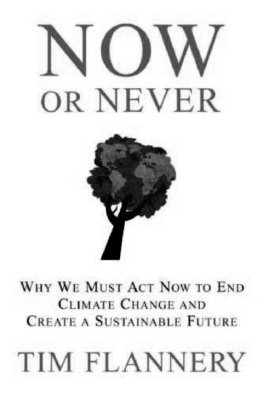
I HAVE mixed feelings about our future. Emissions have grown too fast, and theirimpactsonthe climate system have been severe. And Ive had my hopes dashed oncebefore,inCopenhagen in 2009, making it hard to place my remaining reserves of hopeintheParis climate meeting. But I also feel that things have changed fundamentally,andforthe better, in the last few years. The threats are accelerating beyond expectation,butsoare the opportunities. There is real hope in the IEA findings that globalemissionsgrowthhas stalled even as the economy has grown. And the clean energyrevolution,withits promise of clean power and electric vehicles, now seems unstoppable.Moreover,thearguments of the deniers are now transparently wrong, and outdated.Thethoughtthat they might deny the world a last chance for a better climate futureisperverse.Even grotesque.
I grew up in an age of technological optimism. We thought that each decade wouldbe better than the last. I thought that this was the way it would always be. Butspeaking to young people today, I realise that they have a very different view. Theyfear that their lives will be poorer, less stable, less enjoyable than those of theirparents and grandparents. I want them to know that there is hopethat their new-foundvoice is making a differenceand, whether through activism, community projects orbuilding new, green businesses, they will change the world. But members of oldergenerations still have a disproportionate influence. Younger people need to be giventhe chance to create a better world for themselves.
Above all, its now clear that the tools required to avoid a climate disaster alreadyexist, even if some of them require more research and development. Between deep,rapid emissions cuts and third-way technologies, we can do it. It really is overto you. Every one of you. We can now see the finishing line. Whether we win the racefor a better future is your choice.
Climate Communicators & Research Organisations
Carbon Tracker Initiative: carbontracker.org
Climate CoLab: climatecolab.org
The Climate Council: climatecouncil.org.au
The Climate Institute: climateinstitute.org.au
Climate Outreach and Information Network (COIN): climateout-reach.org.uk
ClimateWorks: climateworks.org
Doctors for the Environment Australia: dea.org.au
International Institute for Environment and Development: iied.org
Responding to Climate Change (RTCC): rtcc.org
Climate Advocacy
1 Million Women: 1millionwomen.com.au
Australian Conservation Foundation: acfonline.org.au
Avaaz: avaaz.org/en/index.php
CARE Climate Change: careclimatechange.org
Ceres: ceres.org
Citizens Climate Lobby: citizensclimatelobby.org
The Climate Reality Project: climaterealityproject.org
Conservation International: conservation.org
Friends of the Earth: foe.org
Greenpeace: greenpeace.org/international/en
The Wilderness Society: wilderness.org.au
WWF: worldwildlife.org
Climate Action Networks
Climate Action Network: climatenetwork.org
Global Call for Climate Action: tcktcktck.org
Renewable Energy
Clean Energy Council: cleanenergycouncil.org.au
International Renewable Energy Agency (IRENA): irena.org
REN21Renewably Energy Policy Network for the 21st Century: ren21.net
Solar Aid: solar-aid.org/about
Solar Citizens: solarcitizens.org.au
Divestment
350.org
Divest-Invest Philanthropy: divestinvest.org/philanthropy
Climate Youth Movements
Australian Youth Climate Coalition: aycc.org.au
Canadian Youth Climate Coalition: ourclimate.ca
China Youth Climate Action Network: cycan.org
UK Youth Climate Coalition: ukycc.org
Compiled by Max Newman, Australian Climate Council
Many people have contributed to this book through their discussions and encouragement.David Kent of HarperCollins Canada and Michael Heyward of Text Publishing, Australia,played an important role in convincing me that the book should be written. DavidAddison and Adepeju Adeosun of the Virgin Earth Challenge provided much encouragement,insight and editorial assistance. Alan Knight, while Director at Business in theCommunity, provided valuable input, including the suggestion that certain technologiesshould be called the third way. Professors David Karoli and John Wiseman of MelbourneUniversity, and Professor Will Steffen, Dr Martin Rice and Amanda McKenzie of theAustralian Climate Council all read early drafts and provided invaluable commentary.
INTRODUCTION
The most recent year such figures are available.
CHAPTER ONE
Knutson, T. et al., Multimodal Assessment of Extreme Annual-Mean Warm AnomaliesDuring 2013 over Regions of Australia and the Western Tropical Pacific, in Herring,M. P. et al., Explaining Extreme Events of 2013 from a Climate Perspective, Bulletinof the American Meteorological Society (BAMS) 95, 9, September 2014, pp. 2630. Lewis,S. C. and Karoli, D. J., The Role of Anthropogenic Forcing in the Record 2013 Australia-wideAnnual and Spring Temperatures, in Herring, M. P. et al., BAMS, September 2014,pp. 3134. King, A. D. et al., Climate Change Turns Australias 2013 Big Dry intoa Year of Record-Breaking Heat, in Herring, M. P. et al., BAMS, September 2014,pp. 4145.
Cooper, M., Death Toll Soared during Victorias Heatwaves, Age, 6 April 2009.
Robine, J. et al., Death Toll Exceeded 70,000 in Europe during the Summer of2003, Comptes Rendus Biologies, 331, 2, 2008, pp. 17178.
Stott, P. A. et al., Human Contribution to the European Heatwave of 2003, Nature432, 610614, 2004.
Melillo, J. M., Richmond, T., Yohe, G. (eds.), Highlights of Climate Change Impactsin the United States: The Third National Climate Assessment, US Global Change ResearchProgram, 2014.
Barriopedro, D. et al., The Hot Summer of 2010: Redrawing the Temperature RecordMap of Europe, Science 332, 2011, pp. 22024.
Price, C. and Rind, D., Possible Implications of Global Climate Change on GlobalLightning Distributions and Frequencies, Journal of Geophysical Research, 99, D5,1082331, 1994.
Hughes, L. et al., Heatwaves: Hotter, Longer, More Often, Australian Climate Council, 2014.
Hughes, L. et al., Heatwaves: Hotter, Longer, More Often, Australian Climate Council, 2014.
Hughes, L. and Steffen, W., Be Prepared: Climate Change and the Australian Bushfire Threat, Australian Climate Council, 2014.
Ibid.
Balshi, M. S. et al., Assessing the Response of the Area Burned to Changing Climatein Western Boreal North America Using Multivariate Adaptive Regression Splines (MARS)Approach, Global Change Biology 15, 578600, 2009.
Johnson, F. H. et al., Estimated Global Mortality Attributable to Smoke fromLandscape Fires, Environmental Health Perspectives 120, 695701, 2012.
Spracklen, D. V. et al., Impacts of Climate Change from 2000 to 2050 in WildfireActivity and Carbonaceous Aerosol Concentrations in the Western United States, Journalof Geophysical Research 114, D20301, 2009.
Melillo, J. M., Richmond, T., Yohe, G. (eds.), Highlights of Climate Change Impactsin the United States: The Third National Climate Assessment, US Global Change ResearchProgram, 2014.
McMichael, A. J., Health Impacts in Australia in a Four Degree World, in Christoff,P. (ed.), Four Degrees of Global Warming: Australia in a Hot World, Routledge, Abingdon,2014.
Melillo, J. M. et al. (eds.), Highlights of Climate Change Impacts in the United States: The Third National Climate Assessment
Next page













